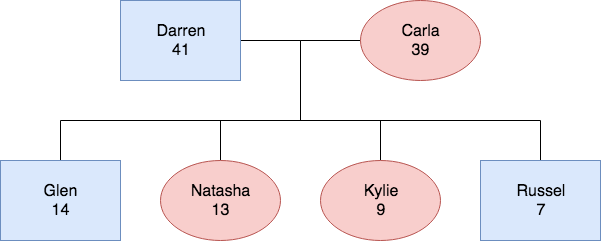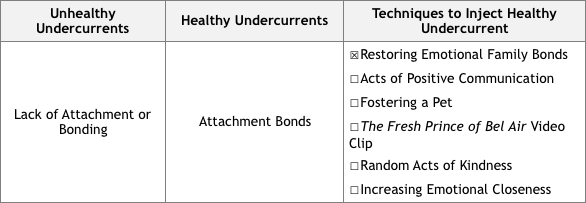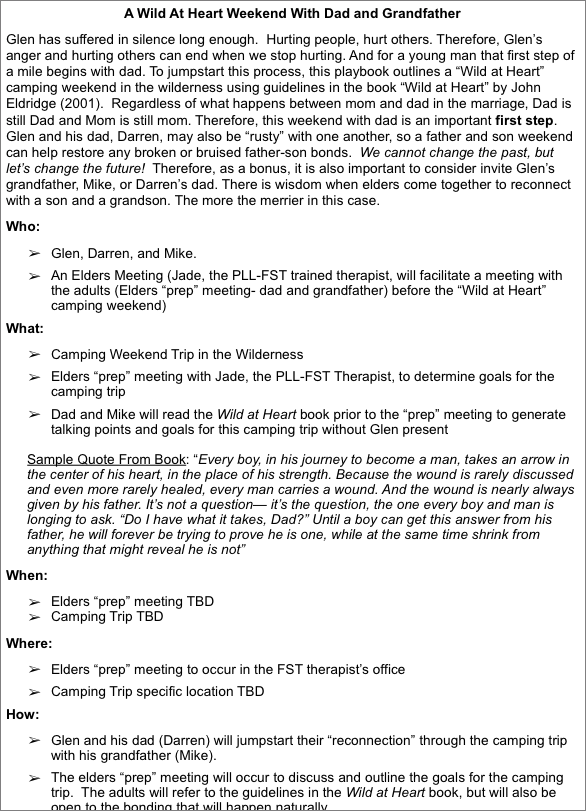Ever see the famous ending scene in the 1996 movie “Jerry McGuire”? Jerry McGuire, played by Tom Cruise, tells his wife, “I love you. You complete me,” and keeps rambling… eventually, Dorothy Boyd, played by Renée Zellweger, shuts him up and tells him, “You had me at hello.” If you have not seen the scene, you can view it.
This month’s case and playbook spotlights what can happen when a lost boy, Glen, is found again. Glen, metaphorically tells his father, Darren, “You had me at hello”. Talk is cheap, but the actions of a simple weekend camping time ignites the spark for healing and forgiveness. And when that same father also invites his own father along, we see how multi-generational wounds can be healed simultaneously.
As the movie shows, our wounded children and especially our lost boys are begging for their lost fathers to restore attachments or bonding by walking a mile with just the first step.
For many boys, fathers, and grandfathers a first step towards healing trauma can be found in the wilderness:
Where there are no deadlines, cell phones, or committee meetings. Where there is room for the soul and a quiet place to restore lost nurturance.
And best of all, a camping trip does not cost much money (a sleeping bag, a blanket, and a car or bus to get to a campsite). And this technique and playbook can also be adapted for mothers and daughters, fathers and daughters, mothers and sons, or children in foster care. The idea and inspiration for this technique and wound playbook came from the New York Times bestselling book by John Eldridge, Wild at Heart (2011).
Case Study*
*To protect confidentiality, all first names and last names have been changed with identifying information altered.
Please Note: You can send a stuck case for consideration to be reviewed and highlighted for our monthly playbook section. Please email us at info@familytrauma.com. If your case is selected, Dr. Sells will contact you directly.

- Darren (41) and Carla (39) have been in a relationship for 15 years.
- Darren is a truck driver while Carla has been a fulltime parent and stays home much of the time.
- At Christmas, Darren and Carla separated and Darren is living away from home. The couple want counseling with the hope of reconciliation but have not started yet.
- They have 4 children: Glen (14), Natasha (13), Kylie (10), and Russell (7).
- Since his father moved out, Glen’s behavior deteriorated significantly in the last 4 months. Glen is frequently violent towards his mother and sister.
- Recently, Glen threatened his mother with a knife and the police were called. Glen is now in a temporary respite home, with an ADVO (Apprehended Domestic Violence Order) restraining him from visiting his family until they have family therapy, and everyone feels safe for him to return.
Next Steps
Using the Family Systems Trauma (FST) model, there are three core treatment steps needed to create a playbook:
Step 1: What Problem Symptom(s) Are Addressed First and Why?
- In the Smith family, the first symptom that needs to be addressed is Glen’s AGGRESSION or violence towards his mother or sister.
- The FST Model utilizes a “safety first” paradigm. Glen’s problem symptom of aggression must be stopped before proceeding to other symptoms (i.e., ADHD, disrespect, marital issues, etc.)
- To alleviate or eliminate the symptom of aggression, treatment can move either towards what we metaphorically call “weed” work or family systems trauma “root” work.
- Using a “weed” work framework, aggression could be immediately reduced through psychotropic medication or external controls like jail or hospitalization. These external controls would likely stop the aggression immediately but fail to get at the “root” cause (what is driving the symptom).
- As a result, when the effects of the medication wear off or jail or hospitalization is finished, Glen’s symptoms of aggression would likely return. This is termed “first order change”- temporarily changing the environment or chemical imbalance in the brain (weed work) without “second order change,”- change to the core interactional patterns or undercurrents driving the surface symptoms (root work).
- This is a both/and approach. Often, drug therapy and/or external controls are needed to get overwhelmed parents or a family immediate symptom relief. Once stabilized, “root” work is often needed for second order change.
- In Glen’s case, “root” work could be addressed immediately to quickly stabilize aggression at the surface level. This happened here when Step 2 revealed the root cause to be the damaged attachment bond between Glen and his father or what are called the primary unhealthy undercurrent(s) driving the surface symptoms.
Step 2: Locate the Unhealthy Undercurrent(s) that Cause the Child’s Symptom and the Healthy Undercurrent(s) That Will Heal It
- Undercurrents. Are defined as the core interactional patterns in the family that cause the trauma or maintain it (e.g., unforgiveness, unresolved grief, family secrets, abandonment, lack of nurturance) and result in problem symptoms in the child or family. Undercurrents can be labeled as “unhealthy,” keeping the family stuck and unable to heal the underlying trauma, or “healthy.”
- The FST therapist closely examines what are called undercurrent worksheets illustrated in Chapter 6 (pp. 157-158) and must answer this important question privately after Phase I of the FST Model (the diagnostic session with the family). It is called Pre-session Preparation for Phase II:
“What are the top one or two “unhealthy” undercurrents [insert here] that are most likely directly responsible for causing the child’s problem symptom(s) [insert here] and “healthy” counterpart undercurrents that are being targeted to eliminate or alleviate for this particular family?”
Please Note: There will likely be different undercurrents responsible for causing different symptoms. Therefore, just select those undercurrents most likely responsible for the targeted symptom in question.
The Smith Family: Unhealthy and Healthy Undercurrents
- The answer to this key question led the FST therapist to select the following unhealthy and healthy undercurrents as the most likely “root” cause and cure for Glen’s aggression:

- The FST therapist’s rationale for these undercurrent picks was based on the following diagnostic information gathered in the first session:
- Glen’s aggression only began after the father moved out.
- During the session, Glen revealed he missed his dad but “could not forgive him” for leaving the family.
- One could feel the extreme marital tension between husband and wife. The issues were far from resolved. It was likely Glen’s aggression was a diversion for both parents and the siblings. Glen’s aggression was solving a problem in a very unhelpful way.
- There may be a family secret of domestic violence between mother and father that might have caused the father’s sudden departure. Therefore, Glen’s aggression towards his mother and sister might be a way he is acting out the aggression Glen witnessed between his mom and dad.
- A re-connection bond and/or forgiveness between dad and son would likely have a significant positive and direct ripple effect on (a) immediately decreasing Glen’s aggression; (b) moving the dad and mom “off the fence” with reconciliation, separation, or divorce; (c) decreasing the overall tension in the siblings; (d) increasing accountability from father to son towards a permanent end of aggression against woman and others in general; and (e) soften the family system up with success preparing the way for other symptoms and changes in the family.
- It is important to underscore this critical point: The reason the entire family came to treatment was to “fix” Glen’s aggression. Parents are not in treatment for marital issues or sibling problems. Therefore, to not directly treat the problem symptom that the child and family came to treatment for would be a serious tactical mistake. If this happened, the parents would likely not show up for another session. Any hope to treat other problems would evaporate.
- In the FST model, one goes through the identified problem child as the point of entry to change the entire system and beyond. But one must start where the client is, NOT where they are not.
- The entire Smith family was present in this first session as well as the temporary foster care family that Glen was living with and the foster case worker. The reason everyone attended is that treatment goals are set at the beginning of treatment, not during the middle or end. Hence, all the key stakeholders in Glen’s life must be on the same page. Otherwise, silos and splitting are rampant and allow Glen to easily divide and conquer.
Step 3: Select the Technique and Convert Into a Wound Playbook
- After the missing healthy undercurrents are identified and targeted, Step 3 is to closely examine sample techniques and playbooks that synchronize with the healthy undercurrents for the problem symptom(s) targeted. In the Smith family, here is a quick review of the healthy undercurrents to stop Glen’s symptom of aggression:
Healthy Undercurrent Counterparts that Could Heal or Cure Glen’s Symptom of Aggression
- Reestablish attachment with Dad
- Forgiveness, security
A core assumption in the FST model is that we use what are called strategic directives or techniques that act like powerful antibiotics to activate targeted healthy undercurrents and heal trauma. In turn, surface problem symptoms in the child or adolescent (e.g., self-harm, anxiety, depression, aggression) are then eliminated or alleviated. “Wound playbooks” are used to clarify family roles and show how to convert the technique selected into action.
- Once the healthy undercurrents are selected, the FST therapist closely examines the recommended techniques for those particular undercurrents in the following manner:
- Selects a technique and playbook recommended in Chapter 8 of Treating the Traumatized Child book. or
- Creates their own techniques and playbooks
- Each month, Dr. Sells will highlight a new case study and wound playbook that can be used the next day at work that are in addition to the playbooks in Chapter 8 of the book.
- As with anything else, the more playbooks and techniques you see, the more skilled you will be to create them yourself. It is analogous to watching a builder build a house. The more you watch and study an expert builder, the better and more skilled you will build yourself. We begin this first building with this month’s Wild at Heart playbook.
The Wild at Heart Wound Playbook
- The recommended techniques for “Reestablishing Attachment” and “Forgiveness and Security” are listed below:
Recommended Techniques to Fill in Missing Attachment

Recommended Techniques to Fill in Missing Forgiveness and/or Security

The Wild at Heart Playbook

What Can We Learn?
There are several reasons why this particular wound playbook was created and selected for the Smith family and would be useful for your families or foster families.
At the very beginning of the playbook there is an important theme or reframe: Hurting people hurt others and aggression is a by-product of a lost boy who is deeply wounded and needs to reconnect with his dad and grandfather. When a boy is aggressive to a woman it can in large part be traced back to a father who never bonded with his son or never showed him what it takes to be a man who does not abuse woman. Healthy masculinity is not genetic. It must be taught.
Glen’s first reaction when he first saw this playbook spoke volumes and why the theme is “you had me at hello”. Glen’s tears were saying to his Dad, “you had me at hello” because Glen knew intuitively that the camping trip could give his Dad the roadmap he so desperately needed to go from talk or inaction to actual practice.
And it is highly likely that this wound is generational. Darren likely never bonded with his father, Mike. Hence, the invite is to both men. They have another chance to reconnect and see how this will help Glen heal and in turn, be a better father when he has children someday. Or a legacy for Darren and Mike’s yet unborn future grandchildren. This is why there is an elders’ meeting behind closed doors to make these connections and see that this is not just an ordinary camping trip but one that can light the spark of deep healing.
Jade is a woman therapist. Would be ideal for this intervention to be delivered by a male therapist? Probably, but clients will “do well if they can”; therefore, a powerful technique and playbook hitting on the right undercurrent will unleashed untold positive energy and heal spiritual pain to such a degree that gender can be important but not a “must have” to make the needed change necessary.
The Wild at Heart book also has a spiritual theme with the message that all boys want to hear which is “you have what it takes”. Both Darren and Mike were likely never validated with this core message. And without this message it is difficult, if not impossible, for a boy to grow into manhood and not try to get this message from much less healthy mean (i.e. pornography, power and control, drug addiction, workaholism, etc.).
Even though there is not “direct” apology intervention within this playbook, it is indirectly present. The elders “prep” meeting with the FST therapist beforehand was used to help facilitate this understanding and help the father and grandfather pre-plan for opportunities during the camping trip whereby forgiveness could be fostered on multiple levels with multiple generations. Pairing these two themes together dramatically increased the likelihood that Mark and his father reconnected on this level as well as Darren and his dad, Mike.
When a family system is stuck, family members desperately need a clear playbook with clarity of roles in the format of “who?”, “what?, “where”, “when?”, and “how?” to jump start healthy undercurrents. And the Smith family was no different, Jade, the FST therapist could not give the technique of a camping trip or even how to apologize without a clear typed out playbook.
Professional sports teams use playbooks in spring training, so why would will we as therapists not mirror this same process with our families. Otherwise, we set up our families for failure.
Some therapists are either uncomfortable or untrained in “directive” therapy and instead want to be “non-directive” and avoid giving direct advice. For some populations, a non-directive style of therapy works. But for traumatized children and families who are stuck, they need you, the therapist, to give them direct advice and typed out playbooks with clarity of roles to help them get unstuck in the here and now.
One successful playbook will not heal the entire Smith Family. But if executed properly, it will give the Smiths one thing they desperately need…hope, a quick victory, and the release of other healthy undercurrents that may be temporarily in a coma. From this hope and success, other playbooks can be developed (marital playbooks, disrespect contracts, ADHD playbooks, etc.) that will spring board this family to further second order change.
Important Final Message
After successfully creating and delivering the playbook, the family is understandably ready to implement it as soon as the session concludes.
This is a huge mistake because the family has not practiced their delivery of the playbook(s) through role-plays (dress rehearsals) and troubleshooting that occurs during Phase IV of the FST Model (see Chapter 11: Phase IV- Troubleshooting and Dress Rehearsals of the book Treating the Traumatized Child for how to do this step).
Without practice dress rehearsals, it is like sending a football team out on the field with a playbook but with no practice drills ahead of time. The football team would not only lose, but they would lose big. This parallel example was conveyed to Glen and his family. And because of the trust and rapport built up to this point, the family agreed to wait until we completed the role plays.
Whether you read Chapter 11 or not, please consider role plays before final playbook implementation.
Postscript
Playbook article in future months will not need the detail on implementation that this one needed. It was done this month to help the reader successfully implement this playbook with or without a purchase of the book. Future playbooks will refer back to the core implementation steps outlined here when a refresher as needed.
As a reminder: You can send a stuck case for consideration to be reviewed and highlighted for our monthly playbook section. Please email us at info@familytrauma.com. If your case is selected, Dr. Sells will contact you directly.
Scott P. Sells, PhD, MSW, LCSW, LMFT, is the author of three books, Treating the Tough Adolescent: A Family-Based, Step-by-Step Guide (1998), Parenting Your Out-of-Control Teenager: 7 Steps to Reestablish Authority and Reclaim Love (2001), and Treating the Traumatized Child: A Step-by Step Family Systems Approach (2017). He can be contacted at spsells@familytrauma.com or through LinkedIn.

